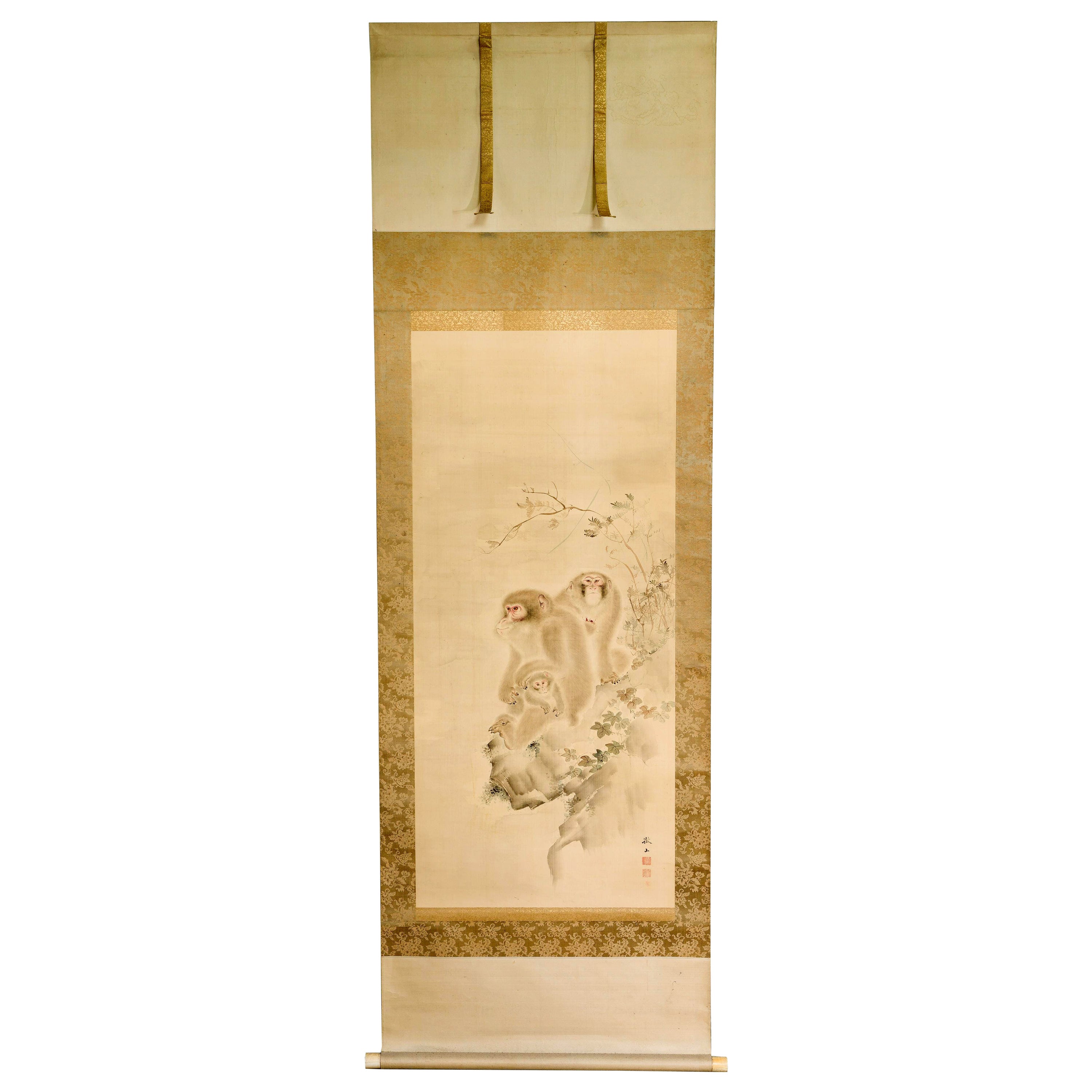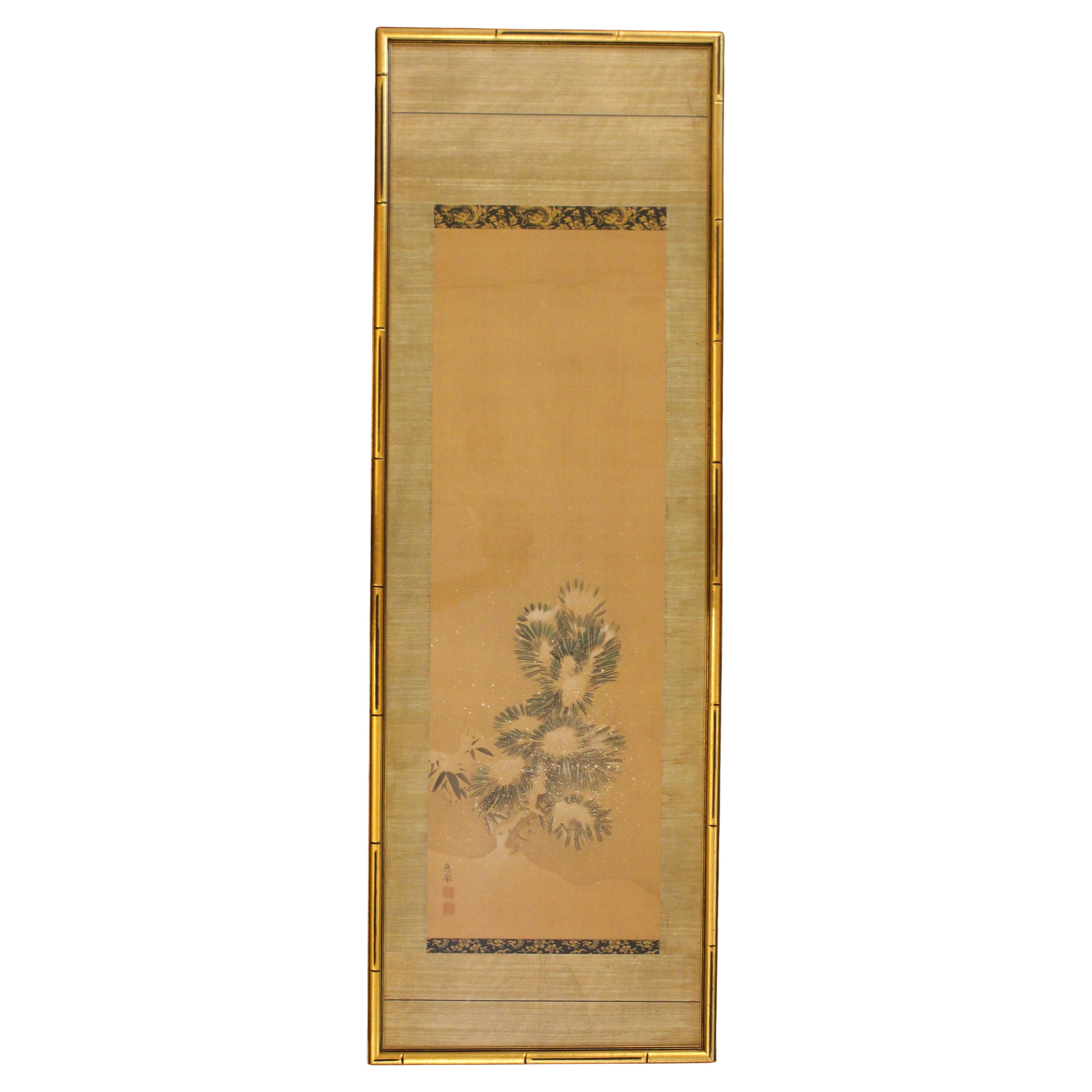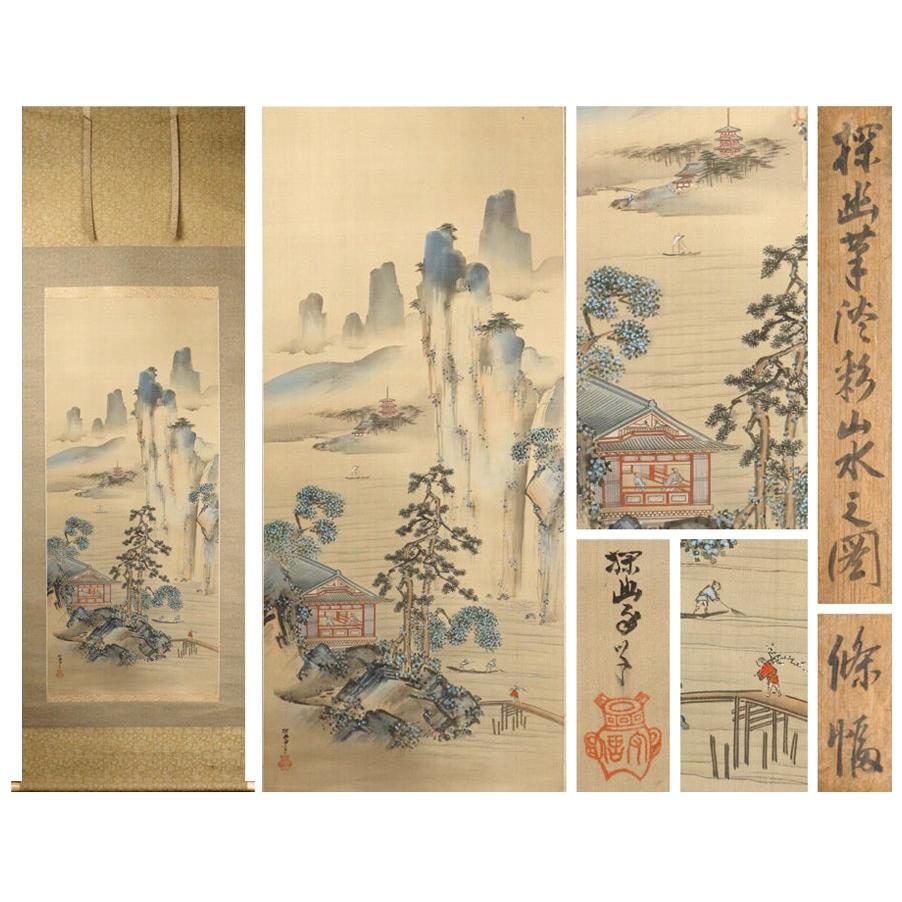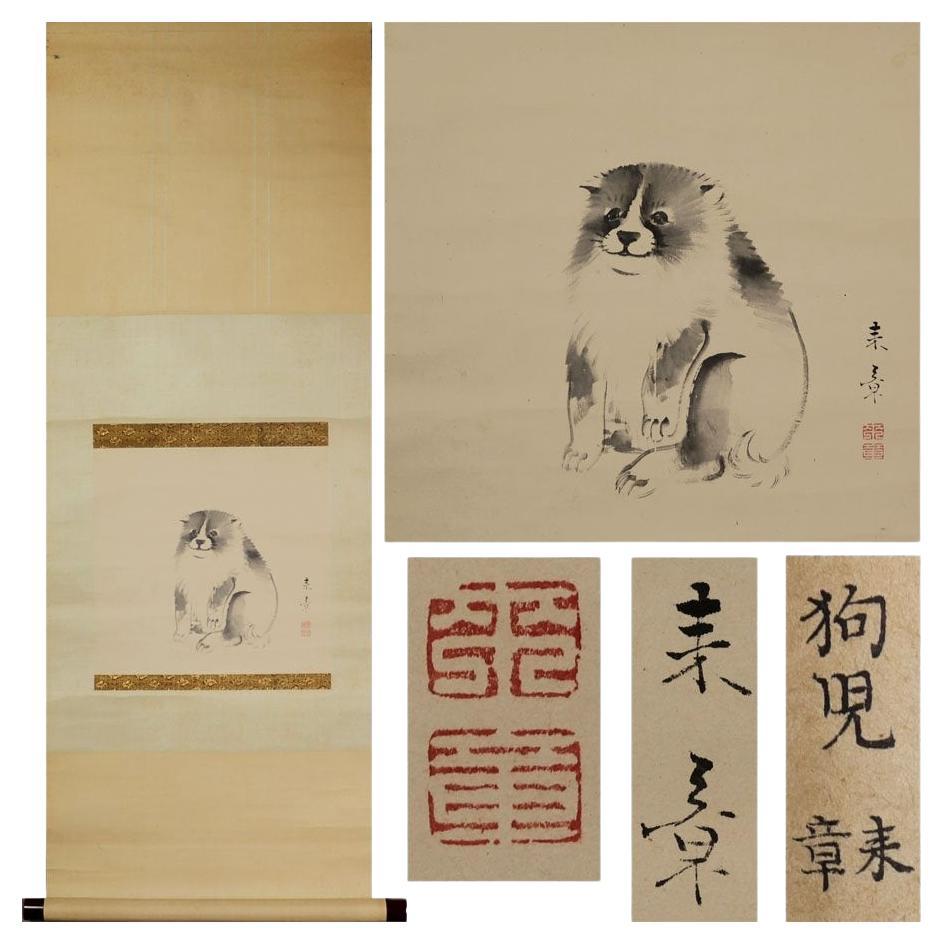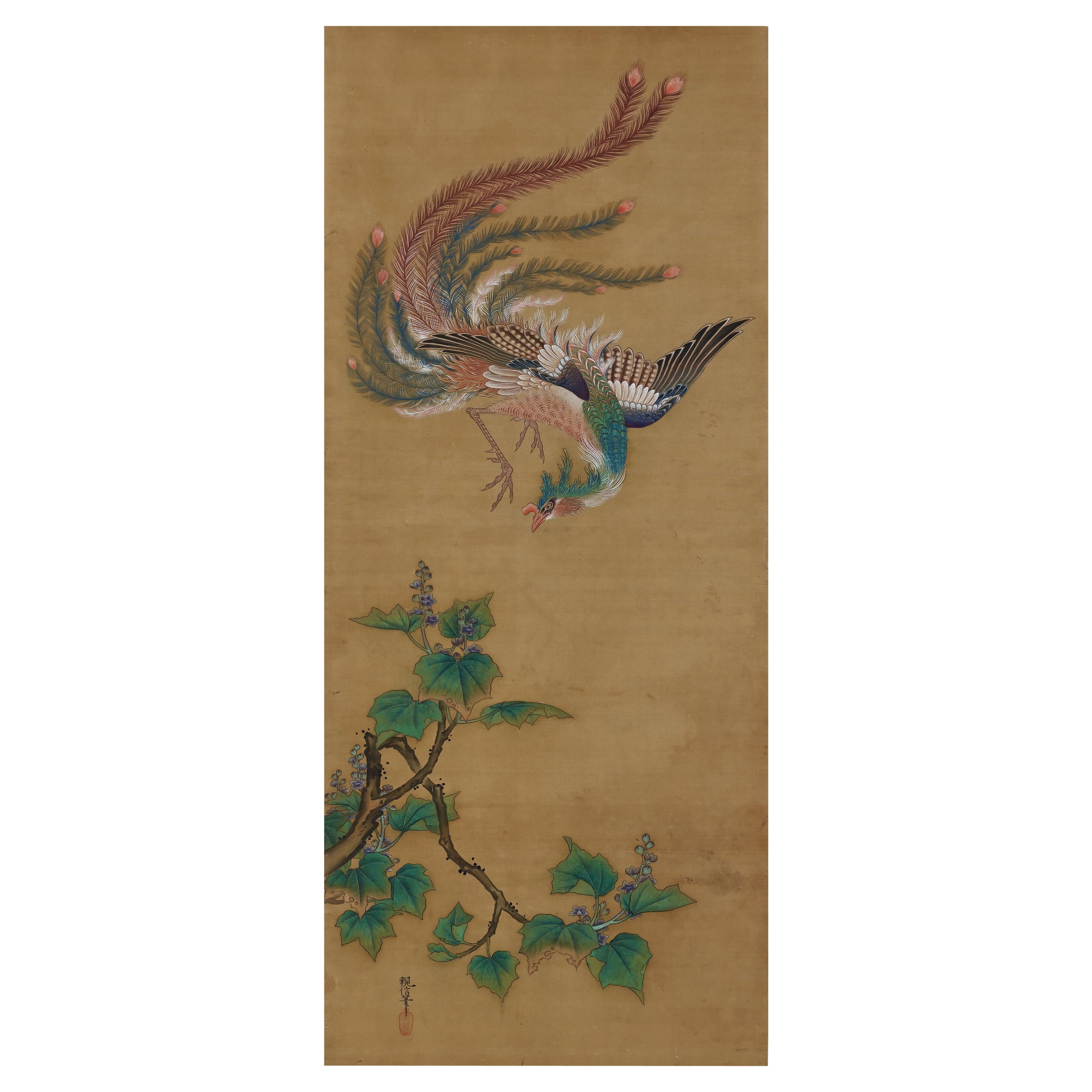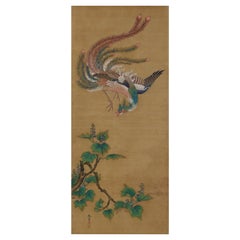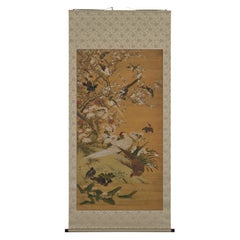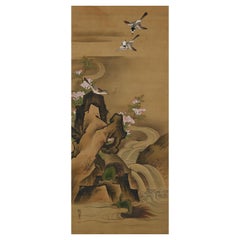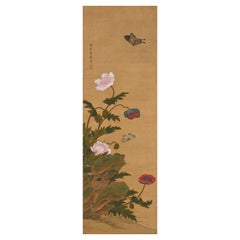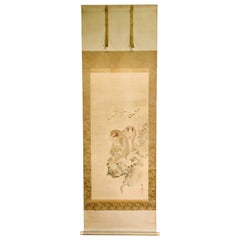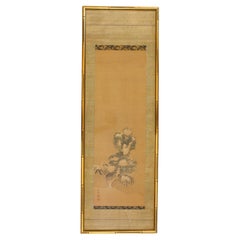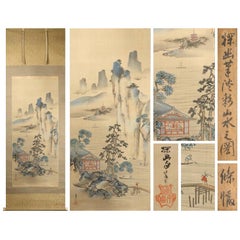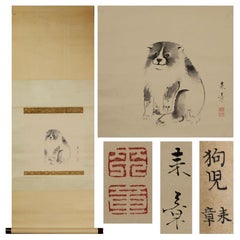Items Similar to 1844 - Chichi, Japanese Scroll Painting. Colour on Silk
Want more images or videos?
Request additional images or videos from the seller
1 of 6
1844 - Chichi, Japanese Scroll Painting. Colour on Silk
$5,400
£4,065.70
€4,723.80
CA$7,603.27
A$8,470.59
CHF 4,443.79
MX$103,459.52
NOK 56,266.90
SEK 52,726.74
DKK 35,259.41
About the Item
Mother’s Breast (Chichi) 1844
Hanging scroll. Ink, pigments and gofun on silk.
Inscription:
Kouka era, dragon year, late winter, painted by Shozan Yashou
Artist’ seals:
Yashou
Suishi
Shozan
Dimensions:
Image: 43” x 16.5” (110 x 42 cm)
Scroll: 72” x 22.5” (183 x 57 cm)
This work by Shozan Yashou, an unidentified artist of the late Edo period, playfully expresses the mother dog’s exhaustion as her pups play with carefree abandon. The brilliantly blooming hibiscus and white morning glories denote late summer/early fall.
This endearing subject showcases the artist’s brush skills and the careful portrayal of plants and animals reveals a close study of nature. The dog’s fur has been depicted with fine brush lines and exquisite detail. The striking colour scheme has been achieved with vivid pigments, ink and delicate gofun (a gesso-like paste made from powdered shells).
A very rare subject in Japanese art though not unrecognized. In 1939, the literati painter Yano Kyoson painted an analogous scene on a pair of two-panel screens titled ‘Chichi’, or ‘Mother’s Breast’.
- Creator:Shozan Yashou (n.d.) (Artist)
- Dimensions:Height: 72 in (182.88 cm)Width: 22.5 in (57.15 cm)Depth: 1 in (2.54 cm)
- Style:Edo (Of the Period)
- Materials and Techniques:
- Place of Origin:
- Period:
- Date of Manufacture:1844
- Condition:Refinished. Wear consistent with age and use. Conservation and full re-mounting undertaken in Kyoto utilizing traditional techniques and craftsmen.
- Seller Location:Kyoto, JP
- Reference Number:1stDibs: LU2472313374941
About the Seller
5.0
Recognized Seller
These prestigious sellers are industry leaders and represent the highest echelon for item quality and design.
Established in 2001
1stDibs seller since 2016
70 sales on 1stDibs
Typical response time: 6 hours
- ShippingRetrieving quote...Shipping from: Kyoto, Japan
- Return Policy
Authenticity Guarantee
In the unlikely event there’s an issue with an item’s authenticity, contact us within 1 year for a full refund. DetailsMoney-Back Guarantee
If your item is not as described, is damaged in transit, or does not arrive, contact us within 7 days for a full refund. Details24-Hour Cancellation
You have a 24-hour grace period in which to reconsider your purchase, with no questions asked.Vetted Professional Sellers
Our world-class sellers must adhere to strict standards for service and quality, maintaining the integrity of our listings.Price-Match Guarantee
If you find that a seller listed the same item for a lower price elsewhere, we’ll match it.Trusted Global Delivery
Our best-in-class carrier network provides specialized shipping options worldwide, including custom delivery.More From This Seller
View All19th Century Japanese Silk Painting by Kano Chikanobu, Phoenix & Paulownia
Located in Kyoto, JP
Birds & Flowers of the seasons
Pheasants & Plum in Snow
Unframed painting. Ink, pigment and gofun on silk
Kano Chikanobu 1819-1888
Signature...
Category
Antique Mid-19th Century Asian Edo Paintings and Screens
Materials
Silk
19th Century Japanese Scroll Painting, Birds & Flowers of the Four Seasons
Located in Kyoto, JP
Birds and flowers of the four seasons
Early to mid-19th century
Ink, pigment and gofun on silk
Unidentified artist
Signature: S...
Category
Antique 1830s Japanese Edo Paintings and Screens
Materials
Silk
19th Century Japanese Silk Painting by Kano Chikanobu, Turtles & Azalea
Located in Kyoto, JP
Birds & flowers of the seasons
Pheasants & plum in snow
Unframed painting. Ink, pigment and gofun on silk
Kano Chikanobu 1819-1888
Signature...
Category
Antique Mid-19th Century Asian Edo Paintings and Screens
Materials
Silk
19th Century Japanese Scroll Painting by Igarashi Chikusa, Poppies & Butterflies
Located in Kyoto, JP
Poppies & Butterflies
Ink, pigment and gofun on silk
Igarashi Chikusa (1774-1844)
Signature: Chikusa Ran Zen
Upper Seal: Ran Shuzen
Lower Seal: Kyoho
Dimensions:
Scroll: H. 68” x W. 18” (172cm x 45cm)
Image: H. 38.5’’ x W. 12.5’’ (98cm x 32cm)
This composition shows elegant images of poppies and the butterflies that are inevitably drawn to them. It captures a momentary glimpse into a world both visually dazzling and startlingly realistic. The painting is infused with sensitivity and attention to seasonal change and weather conditions. The thin and fragile poppies are beautifully depicted with brilliant colors and the butterflies are similarly infused with life. The painting is on silk which requires extremely precise painting skills as no element once painted can be removed.
Poppies were a favorite subject of Rinpa school artists through the ages. Originally they were somewhat abstracted but by the age of Sakai Hoitsu...
Category
Antique Early 19th Century Japanese Edo Paintings and Screens
Materials
Silk
Japanese Screen Painting, Circa 1700 'Tales of Ise' by Tosa Mitsusuke
By Tosa Mitsusuke 1
Located in Kyoto, JP
A six-fold Japanese screen by Tosa Mitsusuke (1675-1710), Japan 17th-18th century, Edo period.
The signature reads Shoroku-i ge Tosa sa Konoe Shogen Mit...
Category
Antique Late 17th Century Japanese Edo Paintings and Screens
Materials
Gold Leaf
19th Century Japanese Silk Painting by Kano Chikanobu, Peacock & Bamboo
Located in Kyoto, JP
Birds & Flowers of the Seasons
Pheasants & Plum in Snow
Unframed painting. Ink, pigment and gofun on silk
Kano Chikanobu 1819-1888
Signature...
Category
Antique Mid-19th Century Asian Edo Paintings and Screens
Materials
Silk
You May Also Like
Japanese Silk Scroll Painting of Moneys Edo Period Mori Tetsuzan
Located in Atlanta, GA
A Japanese mounted vertical hanging scroll painting by Mori Tetsuzan (Japanese, 1775-1841) circa 19th century Edo period. The watercolor and ink on silk ...
Category
Antique 19th Century Japanese Japonisme Paintings and Screens
Materials
Silk, Paper
2nd Half of the 18th Century Scroll Painting on Silk by Maruyama Okyo
Located in Chapel Hill, NC
2nd Half of the 18th century Scroll Painting on Silk by Maruyama Okyo now Framed, Japanese. Pine in Snow. Signed along lower left & with artist's seal in red. Acquired in 1967 in Nik...
Category
Antique Late 18th Century Japanese Anglo-Japanese Paintings
Materials
Silk, Paint
Lovely 17th-18th Century Scroll Painting Japan Artist Kano Soyu Painted
Located in Amsterdam, Noord Holland
It is a work that is said to have been drawn by Kano Soyu as you can see.
It is a picture of the light-colored Sansui map carefully drawn to the smallest detail, and the
towering m...
Category
Antique 17th Century Japanese Edo Paintings and Screens
Materials
Silk
$2,997 Sale Price
20% Off
Japanese Nihonga Painting 19th c Edo Scroll by Nakajima Raiaki River landscape
Located in Amsterdam, Noord Holland
[Raisho Nakajima]
lived from 1796 to 1871, at the end of the Edo period and early Meiji period. A person from Otsu, Omi Province (Shiga Prefecture).
His name is Ziqing. His names i...
Category
Antique 19th Century Edo Paintings
Materials
Silk
$1,235 Sale Price
20% Off
Japanese Meiji Riverside Scroll Painting, c. 1900
Located in Chicago, IL
Although western painting was initially embraced during Japan’s Meiji period (1868-1912), artists brought on a revival of traditional painting styles as they sought to create a modern Japanese style with roots in the past. This exquisite hanging scroll demonstrates the preference for soft layering of gray tones with judicious use of color. The landscape is rendered in soft ink washes that subtly distinguish between water, mountain, and sky. The scroll painting...
Category
Early 20th Century Japanese Meiji Paintings and Screens
Materials
Paper
Lovely Japanese 18th-19th Century Edo or Meiji Scroll Painting Seven Lucky God
Located in Amsterdam, Noord Holland
Interesting and finely painted Japanese painting.
Provenance: From an old family from Kyoto.
width of about 62.0 cm axial destination width of about 67.8 cm × length of about 1...
Category
20th Century Japanese Meiji Paintings and Screens
Materials
Bronze
$1,332 Sale Price
20% Off
More Ways To Browse
Antique Brown Paint Color
Scroll Painting
Asian Art Scrolls
Antique Silk Paintings
Hanging Scrolls
Antique Japanese Scrolls
Hanging Screen
Asian Silk Screens And Paintings
Silk Screen Paintings
Ink Scroll
Japanese Painted Silk
Asian Silk Paintings Antique
Japanese Scroll Art
Japanese Silk Paintings
Japanese Silk Screen Painting
Antique Silk Screen Painting
Japanese Brushes
Japanese Hand Scroll
